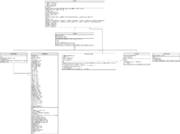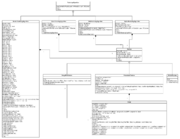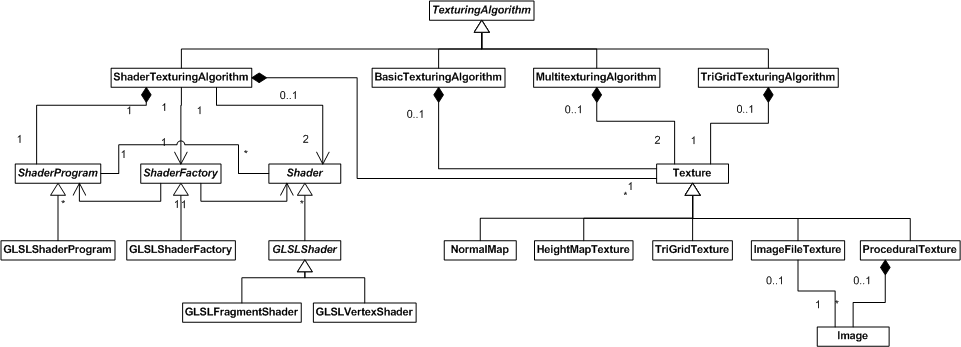Terrain Renderer Design
Contents |
Initial Design
Here is the initial design of the texturing side of the Terrain Renderer. The main piece of code contains one of each kind of Texture. The rendering can then be switched between each texture at runtime. Here's an overview of what each Texture does.
- ProceduralTexture - A texture made up of multiple images. When created, the images are arranged and blended based on the terrain heightmap (higher regions have snow, lower regions have grass etc). This texture is applied 1-1 to the terrain.
- DetailMap - A DetailMap augments the ProceduralTexture method by using hardware Multitexturing to blend some small details to the terrain. The details are repeated a set amount across the terrain.
- TriGridTexture - Mainly for debugging, a TriGridTexture is created mathematically and applied to each polygon of the terrain individually. This way the polygon structure and number can be seen easily.
- BasicTexture - An almost empty class which implements the simplest kind of texture. One that is loaded from a file. However, this particular Texture doesn't know how to draw itself. It is only used by ShaderSplat.
- ShaderSplat - ShaderSplat performs texturing and lighting using Shaders. It doesn't actually contain any texture information, instead it passes some BasicTextures through to the Shaders to process.
In addition to this there is the shader code which consists of two files, a vertex shader and a fragment shader which are compiled and linked at runtime.
Critique
At this stage, Texture seems to have several responsibilities and is therefore a violation of the Single responsibility principle. It is responsible for the OpenGL representation of a texture in video memory as well as how textures are applied to the terrain surface. This may not seem all that terrible, but it limits the capabilities of some of the methods. For example, in the case of the DetailMap, it can only contain a ProceduralTexture but there is no particularly good reason for this to be. If we allow it to contain an abstract Texture, this would allow it to contain a ShaderSplat Texture. Since both these Textures use the graphics hardware directly, it is extremely unlikely that these would cooperate.
ShaderSplat also seems to be quite large. In particular it currently keeps track of the location of each uniform variable in the shader code as seperate variables. It also contains multiple other textures (not seperate Texture classes) to do its job, such as a normal map (which is technically lighting data, but is stored in a texture format and can still be displayed like any other texture).
Seperating Texture Responsibilities
To seperate the two responsibilities of Texture, I created another hierarchy, called TexturingAlgorithm. As the name suggests, it was inspired by the GoF Strategy design pattern. Although not visible in the diagram, a number of TexturingAlgorithms are contained within the terrain rendering code. These algorithms can be switched at runtime (however, they need to be told this explicitly using the use() and clear() methods to setup and cleanup respectively). In doing this I have violated the idea that a Class should be ((RED FLAG))
One interesting thing to note is that we now have a distinct difference between a ProceduralTexture, which uses Images to create a Texture at load-time and a ShaderTexturingAlgorithm which uses Textures and combines them in a similar way at runtime.
Current Problems
One thing that is not obvious from the class diagram (but if you look carefully you might find some methods that point it out), but currently ShaderTexturingAlgorithm actually contains more than the 5 explicit Textures. It creates a normal map (which is a kind of texture that contains lighting information) and passes that through to the GPU. I should actually split this into a seperate subclass of Texture. It also creates something called a distance map, which is experimental and doesn't work correctly. I may end up deleting it, so I won't worry about that for now.
ShaderTexturingAlgorithm of course exhibits the Large class smell and there are some things I can do to help remedy this. One is that I could separate some aspects of Shaders into separate classes. I still have to think about this some more, but I could have a Shader class. Or even better, reflect the OpenGL internals by having a ShaderProgram class which contains a VertexShader and a FragmentShader. One thing that makes ShaderTexturingAlgorithm look larger than it really is, is that it has to keep reference to a number of variables in the shader code (called uniform variables). I could create a UniformVariable class and keep a collection of these in the ShaderProgram class. Each UniformVariable would have a name (as it is in the shader code) and a type (ah, but this might lead to type switches..I'll need to think about that one). A ShaderProgram could then be told to load a value into one of its UniformVariables and the correct OpenGL function needs to be called based on that variables type. Or I could pass that responsibility off by having multiple methods for different types which correspond directly to the OpenGL functions.
Second Redesign
Actually, this is a pretty minor update. I've just pulled the NormalMap out of ShaderTexturingAlgorithm. I also pulled out HeightMapTexture, which I had actually lumped in with the normal map (using the alpha channel). In doing this update I ended up with some nasty bugs which took me a while to fix. So ShaderTexturingAlgorithm is still as large as anything, hopefully my next redesign will be major enough to help with that.
Final Design
In this update, I abstract some of the low level aspects of shaders to their own classes. First we have the Shader class with its two subclasses VertexShader and FragmentShader. Unfortunately because there is no way to force a class to be abstract in C++, I had to make the forceAbstract() abstract method. Not sure if this is the best way to go about it, but I wanted to make sure that a generic Shader could not be constructed. The reason this cropped up is because there is very little difference between the two types of shader. The only difference is that when the shader is constructed in OpenGL, a constant has to be passed which tells OpenGL if it is a vertex shader or a fragment shader, but I thought it was worth subclassing like this so that the client (ShaderTexturingAlgorithm) doesn't need to know about this constant.
Secondly, we have the ShaderProgram class which links Shaders together into a program. It also keeps a map of uniform variables for that program (with the key as the name of the variable and the value as its location in the program). This has helped shrink ShaderTexturingAlgorithm a bit since it doesn't need to keep a reference to the location of these variables anymore. It still needs to know the names of these variables, but this is pretty much a necessary evil, since it has to know how to handle each variable anyway.
One good win is that the setup code for the shaders is a bit more readable. We go from this:
//initialise shaders
glewInit();
vobj = glCreateShader(GL_VERTEX_SHADER);
fobj = glCreateShader(GL_FRAGMENT_SHADER);
const char * vs = readShader("mult.vert"); //Get shader source
const char * fs = readShader("mult.frag");
glShaderSource(vobj, 1, &vs, NULL); //Construct shader objects
glShaderSource(fobj, 1, &fs, NULL);
glCompileShader(vobj); //Compile shaders
glCompileShader(fobj);
pobj = glCreateProgram();
glAttachShader(pobj, vobj);
glAttachShader(pobj, fobj);
glLinkProgram(pobj);
GLsizei *length = NULL;
GLcharARB *infoLog = new GLcharARB[5000];
glGetInfoLogARB(pobj, 5000, length, infoLog);
cout << infoLog;
To this:
//initialise shaders
Shader *vertexShader = new VertexShader("mult.vert");
Shader *fragmentShader = new FragmentShader("mult.frag");
vertexShader->compile();
fragmentShader->compile();
shaderProgram = new ShaderProgram();
shaderProgram->attachShader(vertexShader);
shaderProgram->attachShader(fragmentShader);
shaderProgram->link();
cout << shaderProgram->getLinkerOutput();
One thing I wasn't sure about was how closely I should match the underlying API. I've ended up matching it fairly closely to how I used it. So a vertex shader needs compiling after being created, and a shaderProgram has each Shader attached manually, then finally needs to be linked. This could take a list of shaders or something instead, but I'm not sure if that would be any better.
As suggested by David here's a simpler version of the class diagram:




